Posted in category "Dissent"
Frank McCourt, a former New York City schoolteacher who turned his miserable childhood in Limerick, Ireland, into a phenomenally popular, Pulitzer prize -winning memoir, Angela’s Ashes, died on Sunday, July 19, 2009. He was 78 and lived in Manhattan and Roxbury, Conn. 
“When I look back on my childhood,” McCourt said in Angela’s Ashes, “I wonder how I survived it at all. It was, of course, a miserable childhood: The happy childhood is hardly worth your while. Worse than the ordinary miserable childhood is the miserable Irish childhood, and worse yet is the miserable Irish Catholic childhood.”
The book’s hilarious and irreverent chapter on Mr. McCourt’s preparation for First Communion is reminicent of pre-Vatican II lessons on both sides of the pond.
“He tells us we have to know the catechism backwards and forwards,” Mr. McCourt writes. “We have to know the Ten Commandments, Divine and Moral, the Seven Sacraments, the Seven Deadly Sins. We have to know by heart all the prayers, the Hail Mary, the Our Father, the Confiteor, the Apostles’ Creed, the Act of Contrition, the Litany of the Blessed Virgin Mary…He tells us we’re hopeless, the worst class he’s ever had for First Communion, but as sure as God made little apples he’ll make Catholics of us, he’ll beat the idler out of us and Sanctifying Grace into us.”
The day for First Communion finally arrives. He’s late to church.
“We ran to the church. My mother panted along behind with Michael in her arms. We arrived at the church just in time to see the last of the boys leaving the altar rail where the priest stood with the chalice and the host, glaring at me. Then he placed on my tongue the wafer, the body and blood of Jesus. At last, at last.”
“It’ s on my tongue. I draw it back.”
“It stuck.”
“I had God glued to the roof of my mouth. I could hear the master’s voice. Don’t let that host touch your teeth for it you bite God in two you’ll roast in hell for eternity.”
“I tried to get God down with my tongue but the priest hissed at me, Stop that clucking and get back to your seat.”
“God was good. He melted and I swallowed Him and now, at last, I was a member of the True Church, an official sinner.”
In fact, Frank McCourt ended up to be one of the Church’s principal public antagonists. He delighted in delivering bawdy riffs against what he saw as the church’s hypocrisy, cruelty and joylessness. “I was so angry for so long, I could hardly have a conversation without getting into an argument,” he once said.
Peter Quinn, the novelist and a practicing Catholic, wrote in an email that his friend was neither “contemptuous of believers in general nor Catholics in particular. On a trip we took together in 1998, he went to Mass with me on the Sunday morning that we landed. He respected the fact that I had reached my own peace with the Catholic Church. ‘It’s a good thing,’ he once told me, ‘that you’re raising your kids in the Catholic faith. At least they’ll have a map to follow or throw away. In either case, they’ll know where they are.'”
Mr. McCourt felt it was impossible to fully divorce himself from the church. So when he stood before Pope John Paul II in 2002, accompanying a delegation of 40 mayors from around the world, the little Irish Catholic boy in him took over. He knelt, took the pope’s hand, and kissed his ring.
“I got up and he’s looking at me with his dazzling blue Polish eyes and extraordinary complexion,” Mr. McCourt told the Commonwealth Club of California, “I had a feeling he knew. He knew what a fraud and phony I was. Then I walked away. And I have to admit, as turbulent as my relationship with the church has been (although they don’t know and they don’t care), I was walking on water practically. I was walking on air.”
The last time Bishop Gaillot was feted in the United States was at the 1996 Call to Action Conference in Detroit. The title of his address was, “My Option for the Poor.” You can read it here.
After that, I haven’t heard about him. He is a man who deserves never to be forgotten, although that is what Pope John Paul II hoped, when Gaillot was removed from the Diocese of Evreux, France and appointed to an ancient and fictitious see, Partenia.
The See of Partenia, now located in the desert of Algeria, has not existed in reality since the 5th century when it was in Mauritania. But, thanks to the web, Gaillot managed to outwit the Vatican and continues to teach and pastor via the internet as a “virtual bishop.”
“As Partenia does not exist anymore” says Gaillot, “it becomes the symbol of all who feel like non-existing in society or in the Church. It is a huge diocese without borders where the sun never sets.” Travel to Partenia here.
Bishop Gaillot didn’t start off as a radical. Little by little, his contacts with people who came to see him and events to which he chose to respond led him to some unexpected places:
He called on all Catholics to persist in dialog without condemnation so that the church can, as Jesus did, embrace the dispossessed: those marginalized by poverty; those living with AIDS, those in prison, those ostracized for homosexuality; and ultimately, those struggling on the borderlands of their own Christian faith. 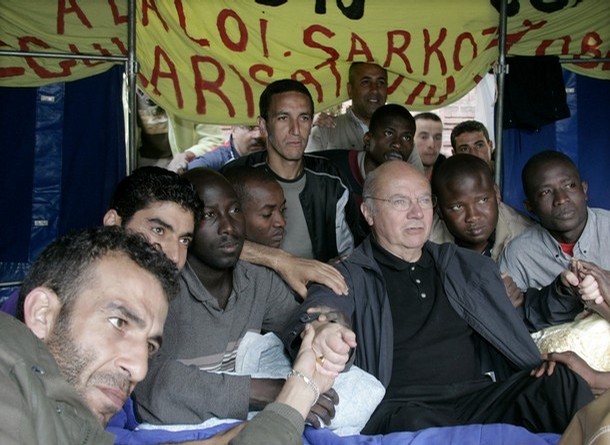
“If we take as our starting point the poor, everything will be renewed – liturgy, catechism, the life of the church. It changes the way we think, pray, our very lifestyle. But if we take as our starting point the Status Quo, we will never be able to catch up with the Good News.”
Gaillot infuriated members of the French Bishops’ Conference and the Vatican with his outspokenness on a number of issues including clerical celibacy, the use of condoms for the prevention of AIDS, ordination of women and married men to the priesthood, and especially, homosexuality.
“The church must be where there is need, and homosexuals have suffered innumerable discriminations. If the church doesn’t free people from oppression, what purpose does it serve?” he asked.
In 1988 Gaillot took the unprecedented step for a Roman Catholic bishop of blessing a homosexual union after the couple requested it in view of their imminent death from AIDS.
He was the only French bishop to participate in the ceremony of the transfer of the ashes of the Abbe Henri-Baptiste Gregoire to the Pantheon, a burial place for “the great men of France.”
Gregoire (1750-1831), a Catholic priest and bishop, was a leading French abolitionist at the turn of the 18th century, a participant in the Revolution of 1789, and a member of its governing assembly.
Gregoire was among the most active deputies of the Assembly, advocated abolishing Negro slavery and granting citizenship to Jews. He objected to some provisions of the Civil Constitution of the Clergy, but agreed to swear the oath of allegiance and was the first member of the clergy to take it (1790). Because of this, the hierarchy of the church refused to give him the last sacraments. (Although he was given them by some sympathetic priests in defiance of the ban.)
After these and other “incidents,” Pope John Paul II relieved Bishop Gaillot of his responsibilities as bishop of Evreux on January 13, 1995. After being removed from his office Bishop Gaillot wrote the following statement:
“I had a dream: to be able to accompany the poor, the excluded, the ignored, without having to explain myself or justify myself to the rich, the secure, or the comfortable. To be able to go where distress calls me without having to give advance notice. To be able to show my indignation at destitution, injustice, violence, the sale of weapons, and managed famines without being considered a meddler in politics.”
“I dreamed of being able to live my faith within the church, but also in society, in my time and with my times. I dreamed of the freedom to think and express myself, to debate and criticise, without fear of the guillotine. I dreamed of the being different within the unity of faith, and remaining myself, alone and yet in solidarity with others. Ultimately, I hoped to be able to proclaim a Gospel of freedom without being marginalised.”
The Leadership Conference of Women Religious (LCWR), an association that icludes the leadership of most U.S. women’s congregations, is under investigation by the Vatican.
Cardinal Levada said the assessment of the LCWR will be conducted by the Bishop of Toledo, Ohio, Leonard P. Blair. Bishop Blair is a member of the U.S. Conference of Catholic Bishops’ Committee on Doctrine. 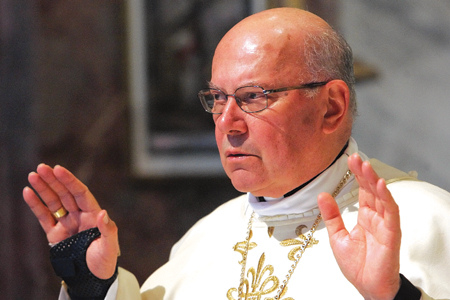
The Vatican assessment became necessary, according to Levada, because at the 2001 meeting between LCWR and the Congregation for the Doctrine of the Faith, which took place in Rome, the women were invited “to report on the initiatives taken or planned” to promote the reception of three areas of Vatican doctrinal concern: the 1994 apostolic letter Ordinatio sacerdotalis, the 2000 declaration Dominus Jesus from the Congregation for the Doctrine of the Faith, and “the problem of homosexuality.”
Cardinal Levada informed conference leaders: “Given both the tenor and the doctrinal content of various addresses given at the annual assemblies of the Leadership Conference of Women Religious in the intervening years, this Dicastery can only conclude that the problems which had motivated its request in 2001 continue to be present.”
The National Catholic Reporter, an independent newspaper, said the Vatican ordered the probe because the sisters had not addressed issues raised by the Vatican in 2001 about their promotion of church teaching on homosexuality, salvation and the priesthood, which the Vatican said is reserved for men.
The ripples from a keynote by Sinsinawa Dominican Sister Laurie Brink at the 2007 LCWR assembly roused the Vatican machinery into action. 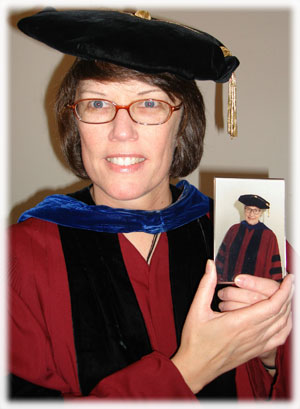
In that keynote address, titled A Marginal Life: Pursuing Holiness in the 21st Century,” Sr. Laurie Brink urged leaders of Catholic religious orders to make clear, if painful choices about the future of religious life. She began with this assumption: “Old concepts of how to live the life are no longer valid.” The rest of the speech outlined four possible options or outcomes as a starting point for discussion.
– “Death with dignity and grace” as opposed to becoming a “zombie congregation” that staggers on with no purpose. This option must be taken seriously, since the average age of the 67,000 sisters and nuns in the United States is 69. Many retreat ministries are closing, and large “mother houses” are struggling with finances, while some congregations no longer invite or accept new candidates.
– Brink noted that some orders have chosen to turn back the clock – thus winning the favor of Rome. “They are putting on the habit, or continuing to wear the habit with zest…Some would critique that they are the nostalgic portrait of a time now passed. But they are flourishing. Young adults are finding in these communities a living image of their romantic vision of religious life.”
– During this era of crisis and decline, some Catholic religious orders have chosen to enter a time of “sojourning” that involves “moving beyond the church, even beyond Jesus.” “Religious titles, institutional limitations, ecclesiastical authorities no longer fit this congregation, which in most respects is post-Christian,” added Brink, a former journalist who is a biblical studies professor at Chicago’s Catholic Theological Union.
For these women, the “Jesus narrative is not the only or the most important narrative…They still hold up and reverence the values of the Gospel, but they also recognize that these same values are not solely the property of Christianity. Buddhism, Native American spirituality, Judaism, Islam and others hold similar tenets for right behavior within the community, right relationship with the Earth and right relationship with the divine.”
She described the Benedictine Women of Madison as having a commitment to “ecumenism” which led them “beyond the exclusivity of the Catholic Church into a new inclusivity, where all manner of God is welcomed. They are certainly religious women, but they are no longer women religious as it is defined by the Roman Catholic Church. They choose as a congregation to step outside the Church in order to step into a greater sense of holiness.”
– Finally, some women are fighting on, hoping to achieve reconciliation someday with a changed, egalitarian church hierarchy. “Theologians are denied academic freedom. Religious and laywomen feel scrutinized simply because of their biology. Gays and lesbians desire to participate as fully human, fully sexual Catholics within their parishes,” Brink said. Many Catholics also oppose the “ecclesial deafness that refuses to hear the call of the Spirit summoning not only celibate males, but married men and women to serve” as priests.
Read Brink’s 2007 address and the keynotes from the LCWR 2008, 2006, 2005, 2004, 2003 and 2003 assemblies here.
The blog, Journey to a New Pentecost, provided a very crisp and thorough assessment of the LCWR investigation. You can read it here.
Brink’s comment about being “post-Christian,” and the sentence: “They are certainly religious women, but they are no longer women religious as it is defined by the Roman Catholic Church,” may have been the spark that ignited the gas can.
Amy Welborn, a Catholic blogger who writes on Beliefnet said: “If you are going to be post-Christian, then be post-Christian. I don’t say that with snark. It’s just reality. If you’ve moved on – move on. Step out from the protective mantle of identity that gives you cachet, that of ‘Catholic nun.'”
Here was a comment on America Magazine’s blog that summed things up for this conservative reader: “The Vatican investigation is long overdue. If you want to be a social worker then be a social worker–not a nun. A nun’s first allegiance is to the Church. I am quite tired of running into nuns who: look like aged hippies, push for women’s ordination, push for abortion, push homosexuality as an ok lifestyle and do this, supposedly, in the name of Christ.”
Sr. Jeannine Gramick, former co-director of New Ways Ministry, commented on the probable political reasons for the investigation: “It is difficult for me to believe that the CDF (Congregation for the Doctrine of the Faith) has not already made a predetermined conclusion. This seems to be the Vatican’s modus operandi. An “investigation” process puts a veneer of fairness to the result. Consider the investigations of theologians like Charles Curran, Leonardo Boff, Roger Haight, etc. etc. No matter what the investigating party does to please them (or not please them) the outcome will be the same. For example, in the Vatican investigation of Fr. Robert Nugent and me, Bob agreed to make some “profession of faith” about the church’s teaching on homosexuality while I refused. The sanction for each of us was identical.”
“In this case, I expect the predetermined outcome to be a change in the canonical relationship of LCWR to the Vatican. The Council of Major Superiors of Women Religious (CMSWR), the traditional group of nuns formed in 1192 by Cardinal Hickey, was not to be the official group representing women religious to the Vatican. By 1195, they not only had canonical status but also were favored over LCWR (e.g., CMSWR had more delegates than LCWR at the synod on Religious Life.) The Vatican would like CMSWR to be the official representative of the leaders of US women’s communities. I think the Vatican is using this investigation to usurp LCWR’s role and replace them with CMSWR.”
I agree with Amy Welborn. I also tend to agree with Jeannine on the politics of the situation. LCWR gave the Vatican the opening it needed by Sr. Laurie Brinks candid–but public–remarks about the choices facing the communities of the LCWR and the options a few members have chosen to pursue. They were imprudent, considering how many enemies LCWR has in the Church.
However, in addition to ideological purity, there is also the issue of property and endowments. These aging communities are sitting on a lot of very valuable real estate. I think the church definitely has an interest in what happens to it when communities begin to fold and the property is sold off. What happens to the money? That may be easier to influence or manage if a more traditionalist group of sisters is involved.
There is another investigation underway running parallel to the investigation of the LCWR.
On March 10, 2009, the Vatican ordered an apostolic visitation of the institutions of the Legionaries of Christ following disclosures of sexual impropriety by the order’s late founder, Father Marcial Maciel Degollado. The letter was signed by Cardinal Tarcisio Bertone, Sectetary of State. It was addressed to Father Alvaro Corcuera, director general of the Legionaries and its lay association, Regnum Christi.
In 2006 Pope Benedict XVI disciplined Fr. Maciel. He was banned from exercising his ministry in public and told to retire to a life of prayer and penitence, following allegations that he sexually abused about 30 boys and young men over a period of 30 years. The Vatican initially stonewalled the sexual abuse investigation for well over a decade.
The Legionaires of Christ were much admired by the late Pope John Paul II for its conservative views, strict loyalty to Vatican teaching, fund raising ability and success in attracting seminarians.
But it was not until Fr. Maciel’s death in 2008 that his secret life was revealed. In February 2009 the Legionaries admitted he kept a mistress and fathered a daughter who is now in her 20s.
The leadership of the order recently admitted that Maciel, a cult figure among Legionaires, led a “double life” after the discovery of his liaison with the mother of his daughter.
Several prominent Catholic commentators said publicly–and some Vatican officials said privately–that the situation called for an outside investigation into the Legionaries of Christ, in order to ascertain the truth, determine whether officials of the order covered up Father Maciel’s misconduct and judge whether Father Maciel’s teachings could still inspire the order.
Also at stake in the investigation is the significant estate Maciel left behind–which his daughter could have a claim to…
The probe could also uncover more cases of sexual abuse similar to those committed by Fr. Maciel.
“We have testimonies that there have been other Legionaires who followed Maciel’s example,” said Jose Barba, the legal representative of eight former Legionaries who started court proceedings against Marciel in 1998. “The ramifications of the problem exist throughout the Legionaires of Christ,” he added.
It will be interesting to compare the end result of each investigation. It will also be interesting to see if Fr. Maciel’s daughter pursues gaining an inheritence or is offered a settlement by the order. Children of priests and bishops laying claim to church property is one of the reasons priestly celibacy became a requirement years ago.
In a March 10, 2009 interview on the Albany radio station Talk 1300, Edward Cardinal Egan, head of the Archdiocese of New York, suggested the Catholic Church would sooner or later have to consider whether to allow priests to marry.
“I think that it’s going to be discussed; it’s a perfectly legitimate discussion,” Cardinal Egan said, replying to a question from the host, Frederic Dicker, about whether the church’s shortage of priests might spur such a change. “I think it has to be looked at. And I’m not so sure it wouldn’t be a good idea to decide on the basis of geography and culture to make an across-the-board determination.” At another point he said: “Is it a closed issue? No. That’s not a dogmatic stand.”
Egan noted that priests in the Maronite and Melchite churches are allowed to be married with “no problem at all.”
Catholic news media, and conversative pundits especially, were in a spin over the cardinal’s remarks. What did he mean?
Were his words a parting gift to reformers? A matter-of-fact response by a canon lawyer–which the cardinal is–to a question involving church law? Or was it aimed at his successor – Archbishop Timothy M. Dolan – who in 2003 soundly rebuffed a discussion by priests in his diocese on the question of celibacy.
Some conservatives dismissed what the cardinal had to say as the comments of a man speaking, as one put it, “above his pay grade.” But many advocates of church reform, who have long considered Cardinal Egan a conservative, said his remarks were surprisingly encouraging, albeit a little late in the day. The cardinal, 76, officially retires on April 15th.
The Rev. Richard Vega, president of the National Federation of Priests Councils. which is affiliated with the U.S. Conference of Catholic Bishops, said such words from a top American prelate, whatever his intent, would “put an issue on the table that a lot of people thought was off the table.” He added: “I think he breathed new life into the hopes of a lot of people.”
One of those people is Sr. Christine Schenk, executive director of FutureChurch, a group promoting the ordination of women and an end to the celibacy rule. “It would have been nice if he had said this five years ago,” she said. “But coming from Egan, I think it is a sign that the conversation is ripening. He’s not the poster child for progressivism. I think it shows we are much closer to having this issue addressed by the Vatican than most people realize.” 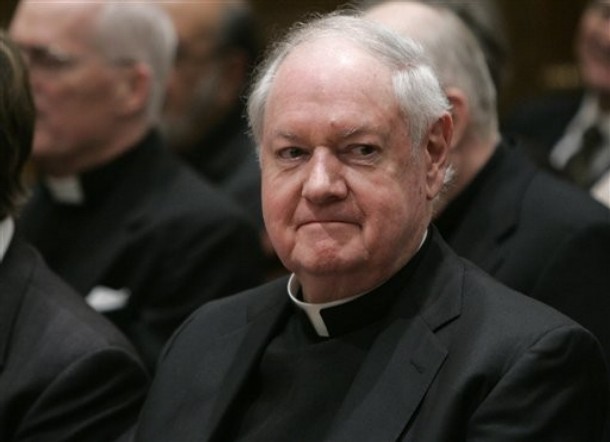
Many church experts said Cardinal Egan’s comments were surprising not so much in their content, but in his willingness to say them in publicly.
“In a sense, what he said was obvious,” said Rev. Thomas J. Reese, Jeusit author and former editor of the moderately liberal Catholic magazine America. “But not many cardinals do that. It was kind of brave of him to say what everybody’s been thinking. It’s interesting that he said it as he was leaving.”
“The church risks becoming a sect. Many Catholics no longer expect anything from this pope. It’s very sad,” Kung said in an interview published by the French newspaper Le Monde on February 24, 2009. 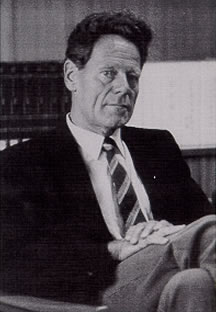
Fr. Kung noted that one of the four traditionalist bishops whose excommunication was lifted by the pope minimized the Holocaust, igniting widespread criticism. The pope’s misjudgement on such an important issue, Kung said, reflected his own isolation.
“Benedict XVI has always lived in an ecclesial environment. He has not traveled much. He’s always remained closed in the Vatican–which is quite similar to how the Kremlin was at one time–where he is safe from criticism,” Fr. Kung said.
Kung went on to way that in his nearly four years in office the pope has shown a lack of pastoral courage and a lack of awareness of the “profound crisis” in the church. He suggested the pope could make several important gestures:
–Allow divorced and remarried Catholics to receive Communion in some circumstances.
–Take steps to “correct” the 1968 encyclical Humanae Vitae and allow the use of birth control in some cases.
–Abolish the rule of priestly celibacy in the Latin-rite church.
–Institute a new way of electing bishops with the involvement of local Catholics.
Fr. Kung said it would be helpful to call a third Vatican council to deal with these and other issues.
Read the Le Monde interview here.
Fr. Kung’s interview provoked some responses that were humorous…or ironic. Here are the best from the web..
Cardinal Angelo Sodano, dean of the College of Cardinals, told Vatican Radio he was “hurt” by reading the interview, and contended that the accusations were “unproven, generic affirmations.”
Cardinal Sodano went on to say “Fraternal criticism has always been possible in the church, from the times of Sts. Peter and Paul. Bitter criticism, on the other hand, especially when it’s so broad, does not contribute to the unity of the church, for which Pope Benedict is working so hard.”
From the blog, Bilgrimage: “Benedict has the reputation for being a great intellectual; yet who more than he has shut down the intellectual life of the Catholic Church, turning it into a sect for the brain-dead.”
From the blog, Enlightened Catholicism: “I expect the blunders will continue unless he decides to launch real reform of the way the church is run. Even in the Vatican you can’t just rely on the Holy Spirit.”
My thanks to the Joseph S. O’Leary homepage, for the above quotes and this rousing call to action: “I suspect in the coming months we will see more initiatives coming from both the laity and clergy calling for real and sustainable change in how Catholicism conducts its business. It will be coming from people who also really love this Church, even the ones who have left in frustration. It’s way past time for these voices to be heard. The conservative wing of this Church has had their say for the last forty years. The results have been disastrous in the West and placing the blame for these results on those who hae left is rather self serving.” 
Fr. Peter Kennedy, 71, was removed as pastor of St. Mary’s, South Brisbane, Australia, by Archbishop John A. Bathersby earlier this week. This action was a tremendous loss not only to the parishioners of St. Mary’s, but all Catholics around the world that look for points of light–parishes, groups, schools, retreat centers, religious people, theologians, authors, bloggers–to take hope and comfort in knowing light from an open door shines for us. 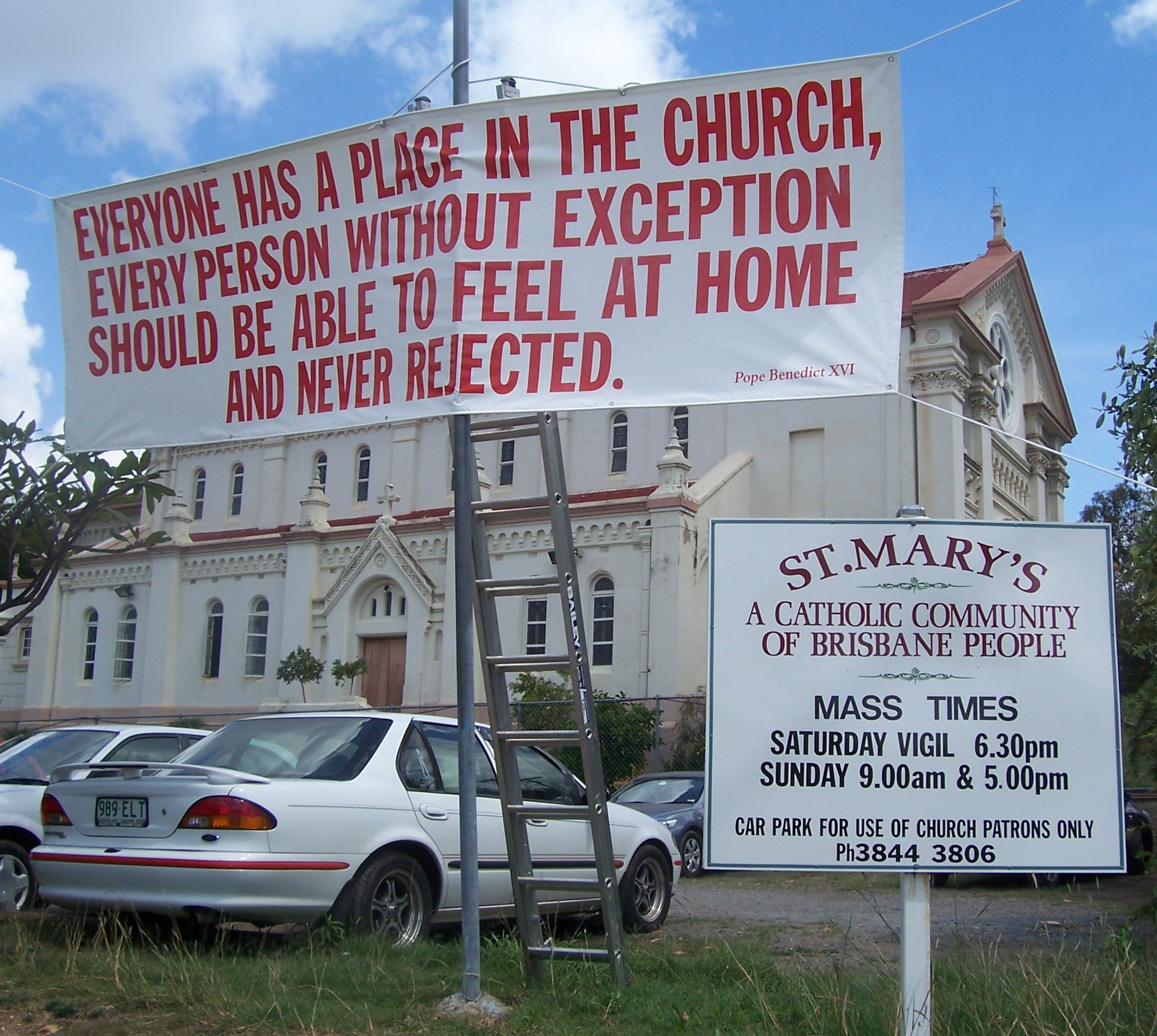
Archbishop Bathersby accused Fr. Kennedy of being “out of communion” with the church by allowing women to preach the homily, giving Communion to gay and divorced people, baptizing babies using unorthodox wording, criticizing the pope and not wearing traditional vestments.
The archbishop’s decree said Fr. Kennedy had “caused harm to ecclesiastical communion in spite of frequent requests from me to do otherwise.”
“The question for me,” said Archbishop Bathersby, “is not so much whether St. Mary’s should be closed down, but whether St. Mary’s will close itself down by practices that separate it from communion with the Roman Catholic Church.”
“In reality St. Mary’s South Brisbane has taken a Roman Catholic parish and established its own brand of religion,” he said. “Undoubtedly it does good, it promotes a strong sense of community, opens its doors to all who wish to come, but its own style of worship and sacramental practice can hardly be described as Roman Catholic.”
The conflict between Archbishop Bathersby and the parish community of St. Mary’s stretches back at least six years.
In 2004 the Archbishop demanded that Fr. Kennedy comply with Redemptionis Sacramentum, follow the liturgical norms and stop baptizing people “in the Name of the Creator and the Liberator and of the Sustainer.” Fr. Kennedy countered that they were doing this to make the sacrament “more inclusive, less patriarchal.” 
The parish previously angered conservatives in the church by welcoming gay couples and allowing the Brisbane Gay and Lesbian Choir to perform there in June 2003 as part of Brisbane Pride Festival celebrations. Archbishop Bathersby opposed the performance and said it was “inappropriate.”
Tony Robertson, who belongs to St. Mary’s, said parishioners were rallying to save their parish. Robertson blogs on Out and About with Tony – A Queer Perspective on Life as a Gay Catholic.
“St. Mary’s is a church which takes seriously its identity as a Catholic community and practices the teachings of the Catholic Church which calls for homosexual persons be accepted with respect, compassion and sensitivity,” Robertson said.
“Such acceptance calls for practical action which welcomes gay and lesbian people to the life and worship of the community.”
Robertson noted that other Catholic churches also welcome sexual minorities, including one church that flies the rainbow flag among its public decorations.
“Those who have concerns about our support for sexual minorities need to remember that the Catholic Church also teaches that every sign of unjust discrimination in their regard should be avoided. In this spirit the Church has opened its doors to the Brisbane Lesbian and Gay Pride Choir who use the Church for weekly rehersals as well as supporting the musical and religious culture of St. Mary’s,” he said.
“Gay and lesbian Catholics who prefer a more traditional worship have always been a presence at the Cathedral of St. Stephen where one of the beautiful stained glass windows is dedicated to a gay member of the famous Mayne Family of Brisbane,” he added.
“Jesus Wept” at the loss of a relationship, not the interpretation of a rule.
Follow the St. Mary’s situation on St. Mary’s Discussion Forum.
Show your support for St. Mary’s on their MySpace page.
Interesting notes on gay history in the Mayne family can be found on page 229 in Colonialism and Homosexuality by Robert Aldrich.
 This week, Pope Benedict XVI received the U.S. Speaker of the House, Nancy Pelosi, her husband and members of her entourage at the close of his regular Wednesday General Audience in Rome.
This week, Pope Benedict XVI received the U.S. Speaker of the House, Nancy Pelosi, her husband and members of her entourage at the close of his regular Wednesday General Audience in Rome.
Pelosi, a self-proclaimed “ardent Catholic,” has sparked criticism from some conservative U.S. Catholic bishops for her pro-choice views. She arrived in Italy on Sunday for an eight-day official visit.
As Speaker of the U.S. House of Representatives, Nancy Pelosi is second in the line of succession to the U.S. presidency, behind only Vice President Joseph Biden, another Catholic who also disagrees with Church teaching on abortion and birth control.
Benedict’s willingness to meet Pelosi gave some pro-life Catholics agita.
By meeting Pelosi, Benedict signaled he wants lines of communication to remain open with the new American leadership, even though there is no meeting of minds over the issue of abortion.
Benedict and Pelosi each issued a statement following the meeting.
“His Holiness took the opportunity to speak of the requirements of the natural moral law and the church’s consistent teaching on the dignity of human life from conception to natural death,” the Vatican statement read, “which enjoin all Catholics, and especially legislators, jurists and those responsible for the common good of society, to work in cooperation with all men and women of good will in creating a just system of laws capable of protecting human life in all stages of development.”
In a statement issued by her office Wednesday, Pelosi said it was “with great joy” that she and her husband, Paul, met Benedict. She said she had praised “the church’s leadership in fighting poverty, hunger, and global warming, as well as the Holy Father’s dedication to religious freedom and his upcoming trip and message to Israel.”
“I was proud to show His Holiness a photography of my family’s papal visit in the 1950s, as well as a recent picture of our children and grandchildren,” said the California congresswoman.
Pelosi’s statement did not mention the pope’s comments on abortion.
The pope’s statement can certainly be read as a rejection of Pelosi’s statements of last summer, when she suggested that the church’s position on abortion had been fluid and ill-defined; and that it’s acceptable for Catholics in public life to take a pro-choice position.
What was said–or unsaid–in that small room in the Vatican that fact remains each of these two Catholic leaders profess to care deeply about the welfare of children–those born as well as the unborn.
The pope cannot be a single issue Catholic–the way some U.S. bishops and pro-life Catholics are–if he is to attend to the Gospel’s work of justice for all, especially people in need.
Before she went to the Capitol to be sworn in as the first woman Speaker of the House, Nancy Pelosi attended Mass at her (and my) alma mater, Trinity College in Washington, DC. The late Fr. Robert Drinan was the celebrant, and he offered the Mass in honor of the children of Darfur and Katrina, praying there that “the needs of every child are the needs of Jesus Christ himself.”
“He challenged us,” said Pelosi of the homily, “by saying ‘Imagine what the world would think of the United States if the health and welfare of children everywhere became the top objective of America’s foreign policy! It could happen–and it could happen soon–if enough people cared.'”
“He continued,’Let us reexamine our convictions, our commitments, and our courage. Our convictions and our commitments are clear and certain to us. But do we have the courage to carry them out? God has great hopes for what this nation will do in the near future. We are here to ask for the courage to carry out God’s hopes and aspirations.”
“As he led us in prayer that day, Father Drinan said, ‘We learn things in prayer that we otherwise would never know.'”
The parishioners are not letting their church get taken from them and sold.
St. Frances Cabrini was among dozens of churches that the Archdiocese of Boston decided to close and sell in 2004, partially to help pay the costs associated with the priestly sex abuse scandal. While most churches closed without a fight, parishioners at St. Frances rebelled.
Kim Brown, 36, said she had become convinced that St. Frances Xavier Cabrini was a victim of its real estate.
Built when this South Shore community was considered the Irish Riviera, the church towers over a wide clearing on the side of a wooded road; ocean views beckon just over the treetops. ”The biggest problem is we have 30 acres of buildable land,” said Marsha Devir, 50.
Brown said church leaders never understood the commitment parishioners had put into the parish and the vigil. ”They’re not seeing the whole picture,” she said. ”They’re just seeing dollar signs. You know what? Sell some of your Vatican jewels. We need this church as a town and as a community.”
For over 1,560 days, the group at St. Frances has taken turns guarding the building around the clock so that the archdiocese cannot lock them out and put it up for sale. They call it a vigil, but for many it has become part of the way of living their faith.
“It’s much more of a living 24-hours-a-day, seven-days-a-week faith,” said Margy O’Brien, 78, a parishioner since St. Frances opened in 1960. “My generation of Catholics have paid, prayed and obeyed, but you get to a point where you’ve had it.”
Many of the people involved in the vigil describe being transformed from passive Catholics to passionate, deeply involved members of a spiritual community that they say could be a model for the future of the church. 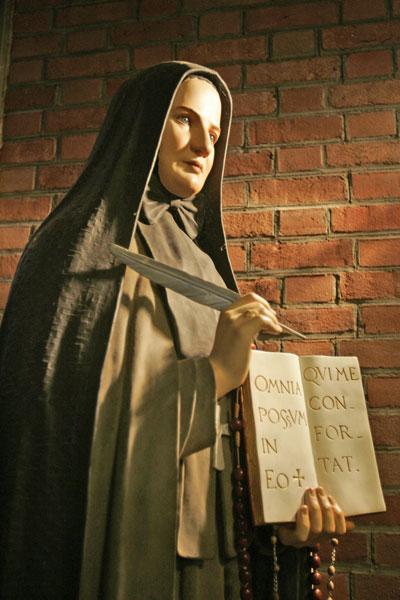
“You would think because there are fewer and fewer priests that the various archdioceses would welcome a new configuration,” Mrs. O’Brien said. “Let the lay people do everything but the sacramental.”
Since St. Frances has no priest, parishioners lead services that include everything but the consecration of the host. On the Sunday before Christmas, about 50 parishioners attended a service conducted entirely by women, including the distribution of Communion. The hosts had been consecrated elsewhere by a priest described by Mrs. MaryEllen Rogers as “sympathetic.”
Parishioners hold suppers in the vestibule and meet Tuesdays to say the rosary. They raise money as a nonprofit group, donate to charities, and open the church to outsiders seeking comfort or repose.
“Lots of troubled people have come through and all they need, really simply, is someone to connect to,” said Karen Virginia Shockley, 43, who participates in the vigil with her two teenage sons. “Usually there’s an older person here who will sit down and just listen to you.”
Some parishioners have grown so disenchanted with the church hierarchy and so fond of the vigil routine that they cannot imagine returning to the old way.
“I cannot go back to the priest and the vestments and all that, I always felt, prince-of-the-church approach,” said Mary Dean, 61, who keeps vigil at St. Frances at least four hours a week. “I’ll always be a Catholic, but I may not be able to worship in the mainstream Catholic Church.”
”A very good thing has happened in this vigil,” Margy O’Brien added. ”A strong faith community has formed. There have been many little miracles happening. People’s lives have been touched, some improved. And I think this group of vigilers will be a strong community forever. I don’t regret doing this at all. Not one moment.”
Fr. Roy Bourgeois, 69, a Maryknoll priest and nationally known peace activist, has been excommunicated for his participation at an ordination rite for women. 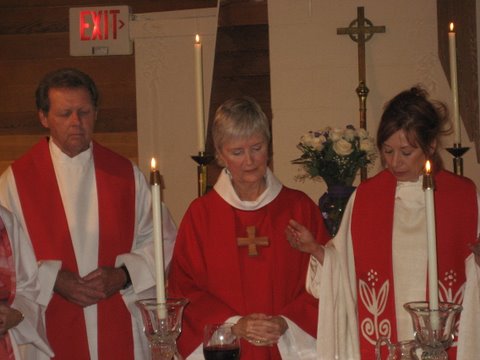
Bourgeois ran afoul of Vatican doctrine by participating in the August 9, 2008 ceremony in Lexington, Kentucky, to ordain Janice Sevre-Duszynska, a member of Roman Catholic Womenpriests. Sevre-Duszynska is the 35th woman to be ordained.
Vatican spokesman Fr. Frederico Lombardi said Bourgeois’ excommunication would be automatic, in other words, a latae sententiae excommunication, effective when the offense is committed. In other words, the person excommunicates himself or herself.
Excommunication is the most severe penalty under church law, cutting off a Catholic from receiving or administering the sacraments.
Fr. Bourgeois said he was following his conscience in his participation at the ordination rite, though it was clearly against the church’s teaching on women’s ordination.
“Conscience is very sacred,” Bourgeois said in his November 7, 2008 letter to Congregation of the Doctrine of the Faith. “Conscience gives us a sense of right and wrong and urges us to do the right thing…Conscience is what compels women in our Church to say they cannot be silent and deny their call from God to the priesthood..And after much prayer, reflection and discernment, it is my conscience that compels me to do the right thing. I cannot recant my belief and public statements that support the ordination of women in our Church.”
James Martin, SJ, a writer and associate editor of America Magazine, noted in its document Dignitatis Humane, the Second Vatican Council wrote: “On his part, man perceives and acknowledges the imperatives of the divine law through the mediation of conscience. In all his activity man is bound to follow his conscience in order that he may come to God, the end and purpose of life. It follows that he is not to be forced to act in a manner contrary to his conscience. Nor, on the other hand, is he to be restrained from acting in accordance with this conscience, especially in matters religious.”
Martin added that the Catechism of the Catholic Church, quoting from Vatican II’s Gaudium et Spes notes, “Conscience is man’s most secret core, and his sanctuary. There he is alone with God whose voice echoes in his depths.”
Fr. Bourgeois was impelled to follow his conscience. He must have known by participating in the ceremony–particularly in the laying on of hands, one of the main symbols of ordination in the Catholic church–his actions would have some serious consequences.
But why did the Vatican feel compelled to enforce canon law and excommunicate him within three months of the event?
In comparison, I do not know of s single instance where a Catholic priest, bishop or other religious has been publicly excommunicated for the sexual abuse or rape of a minor.
Does that mean it’s more of a scandal for a man in good conscience to participate in the laying on of hands in a women’s ordination ceremony; than a man to lay hands on a child for his sexual gratification?
Is something off here?
..says Italian Cardinal Carlo Maria Martini. The cardinal stated 1968 encyclical Humanae Vitae (“Of Human Life”) has cut off the church from many of the people who most need its advice about human sexuality. It may be time, he said, for a “new vision” for sexuality and birth control. 
The encyclical, which teaches that condoms, birth control pills, IUDs and other “artificial” birth control methods are morally wrong, caused a large number of people to stop taking the church’s views seriously, Martini said. “Serious damage was done.”
Martini, an 81-year-old Jesuit and former archbishop of Milan, made the comments in a book-length interview, Nighttime Conversations in Jerusalem: On the Risk of Faith (Conversazioni notturne a Gerusalemme. Sul rischio della fede was published by Mondadori, Milano, 2008)
He did not address specifically the morality of contraception but suggested that the question might be better approached from a more pastoral perspective.
Today, he said, the church might be able to adopt “a new vision” and indicate “a better way” than it did in Humanae Vitae. “The church would regain credibility and competence,” he said.
“Knowing how to admit one’s errors and the limitations of one’s previous viewpoints is a sign of the greatness of soul and confidence,” he said.
Cardinal Martini said the church should take a positive approach to human sexuality, with less emphasis on prohibitions. “Whatever the church affirms, it should be supported by many people, by conscientious in love,” he said.
On a personal note, I was a teenager in the years following Vatican II, and can still feel the reverberations of that era. The cardinal is right when he states the church lost a lot of its credibility after Humane Vitae. More, I think, then even the global priest-child sex abuse crisis of the 1990s.
It is my belief the church lost its footing in the 1960s with its rigidity over birth control and also its dismissal of the Latin Mass.
It has yet to regain it, primarily because of the attitude of the Vatican towards sex and sexuality and their hostility to other voices who question their reasoning. Celibate clerics continue to run the discussion to the exclusion of everyone else. Why are they surprised when no one pays attention?
I believe it was a mistake to toss the Latin Mass out the door so fast. It’s abrupt departure shook a foundation of Catholic identity. The church could have eased the transition by making the Latin Mass more accessible and participatory, and made some accommodation for national, ethic and local customs and observances.
But, that kind of leadership requires flexiblity, listening skills and a willingness to include the laity in decision-making; qualities never much in evidence in the institutional church in that or any other period.
On the subject of birth control, both teenagers AND their parents–even those stoutly against premarital sex (like my parents!)–thought the church’s stance stupid and delusional.
Cardinal Martini is right–the church lost the respect of a generation of Catholics and the strict adherence of the rest. People continued to identify as Catholic, but stopped paying attention to rules, regulations and sins they didn’t agree with. They stopped because they didn’t have any basis in real life, and they weren’t based on common sense.
On the issue of birth control, no family was going to wind up with 8 or 9 children, out of 14 or 15 pregnancies, just because some pampered, out-of-touch celibate decreed it was God’s way.
By the decade of the ’60s, many Catholic men who served in WWII and Korea had gone to college on the GI bill and wanted their children to have a college education. Parents wanted the “better things” in life for their families. This meant having smaller families.
Parents, adults, also had more time and opportunity for sex, and wanted that sex to be a good lusty romp, not a mystical union.
The availability of birth control was the biggest boost to a good sex life. Couples could have sex a lot more, whenever they wanted. Birth control allowed couples to have sex without worrying about unplanned pregancies. This was especially important to women, who always had the fear of pregancy to contend with every time she had intercourse. Not having to worry about getting pregnant was a major boost to a woman’s enjoyment of sex.
The pope should be made aware good sex and lots of it makes for happy Catholics. Not the opposite.
Yes, a “new vision” is needed for the church on sex and sexuality. After 40 years, it’s time to admit Humanae Vitae was a mistake, and move forward to a Catholic view sexuality that is reality-based and natural; not artificial in its prohibitions and fears.










 This week, Pope Benedict XVI received the U.S. Speaker of the House, Nancy Pelosi, her husband and members of her entourage at the close of his regular Wednesday General Audience in Rome.
This week, Pope Benedict XVI received the U.S. Speaker of the House, Nancy Pelosi, her husband and members of her entourage at the close of his regular Wednesday General Audience in Rome.

